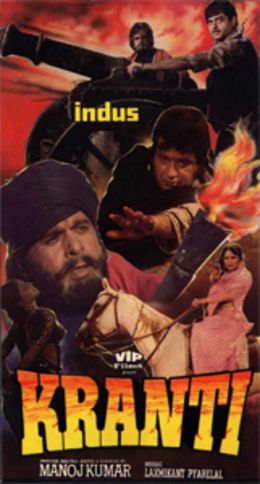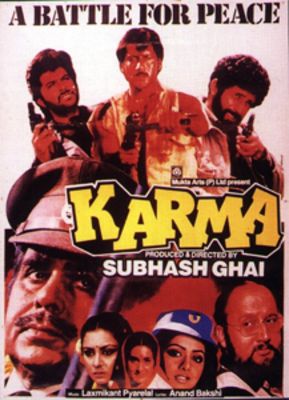Naseeb's other contribution was comic self-parody. That genre began with Amitabh and will go with him (though Mithun and Naseer try it out - the latter specially in T.V. interviews). The 'John-Jani-]anardhan’ number, the farce with Reena, the drunken sequence with Rishi - these are sequences which will repay study by students of popular cinema. The self-parody was vulgarised in the 80s. In Lawaaris it plumbed the depths of transvestism. In Coolie and Mard, it became unamusing gimmickry. The persona parodied became bedraggled, soiled, unworthy even of parody.
Finally, the 80-81 action films were secular - as were those of the 70s. Happy days. The 80s saw the rise of the shoddiest kind of religiosity in action films. One has only to watch a few reels of Coolie, Mard and the recent Zalzala to work out the unholy marriage between violence and religious ritual. This is a gift of the new retrogressive social climate of the 80s.
 |
Kranti, 1981
Manoj Kumār |
Manoj Kumar's
Kranti spawned a different genre - that of patriotic gore. The size and the cost of the film were staggering. It was reduced to a huge slanging match against the British by two of our top thespians (Manoj and Dilip [Kumar]). What is remarkable is the style of
Kranti. It is loudly caricatural, it glories in incredibility and bad taste. It has had an undistinguished progeny. Released in 1981,
Kranti dealing with the British of the mid-l9th century, did not have an identifiable contemporary target. Punjab provided it. Now there's no stopping these gross, chauvinistic, ruthlessly exploitative films - Subhash Ghai's
Karma, Anil Sharma's
Hukumat, B.R. Chopra's
Dehleez and the recent
Commando. These are all 'frontier' films. The enemy across the border is infiltrating agents, the centre cannot hold, the entire nation is in danger. Dilip [Kumar], Naseer [Nasiruddin Shah], Dharmendra, Mithun [Chakravarti] and various sundry junior heroes go to the rescue. The shadow of
Kranti lies particularly heavy on
Karma where, like Dilip and Manoj in the former film, Dilip and Naseer shout each other out. The cheapening of patriotism into mainstream sectarianism constitutes a theme in itself - a base contribution of 80s cinema to our culture. The
portmanteau / umbrella term 'action film' covers many genres, themes, variations. A huge outpouring of such films took place in the 80s. I shall choose four filmg -
Aakhri Raasta,
Shahenshah,
Nayakan and
Kabza for brief discussion.
Nayakan is a Tamil film but I have chosen it because its theme and cinematic presentation light up - both by way of contrast and similarity - the basic themes of Hindi cinema.
 |
Karma, 1986
Subhāsh Ghaī |
Aakhri Raasta and
Shahenshah can be taken together because they explore a familiar groove - honest man / cop driven to unlawful violence by circumstances - in a different fashion. They are not necessarily the best films in this genre but they are certainly representative.The basic themes are: The innocence of the common man which by its very existence in a corrupt society invites exploitation; the shock of disillusionment 'splits' the personality; a kind of cultural schizophrenia results; one 'self' is in love with the freedom of the apache, the urban noble savage, the other clings to the notion of order because 'civilisation' depends on order; both fuse in the lust for revenge.
Aakhri Raasta is the subtler of the two films. The split is between the father and the son both played by Amitabh. The father is the dispenser of revenge,the son is the defender of order. The split has been there since Mother India and Ganga Jamuna. But the split hero of the 80s is more desperate, cruder, more susceptible to a kind of calculated violence than even the 'avenger' of the 70s. The 'variations’ in Aakhri Raasta are two. Even the apache is on the side of order. This is the cloven hoof of the 80s avenger. The Zanjeer hero was the righter of wrongs - pure and simple. The wild father in Aakhri Raasta secretly applauds the Police Inspector son when he upbraids a priest for allowing ammunition to be stored in a graveyard. In this sequence, the treason / hollowness of the 'hero as rebel' is revealed. The 80s rebel hero for all his desperation is a cautious anarchist. He has an ambivalent attitude towards his own mission. When the father in Aakhri Raasta gets his man (politician-raper) the son kills him. Compare this scene with the killing of the rebel son in Aurat and Mother India and you will realise the mean spirit of the 80s. The killing in Aurat and Mother India was in subservience to dharma, a way of life. The killing in Aakhri Raasta is in the service of bureaucracy, in the line of 'duty'.
Shahenshah is cruder than Aakhri Raasta but the theme follows the same pattern. Here the Avenger and the Law Upholder exist in one person but they do not co-exist. There is an attempt at comedy here - Amitabh is bumbling Inspector by day, efficient executioner by night. But both the selves exist to serve order. The apache has taken over the duties of the law enforcer. He is a stage rebel, not a real rebel as in Aurat.
There is a real rebel in Mahesh Bhatt's Kabza but it is not so much the young rebel (Sanjay Dutt), but the Gandhian (Aloke Nath). This is the variation, the twist that takes Kabza out of the vigilante stereotype genre. Kabza portrays not merely the defeat of law but the defeat of Gandhian morality, to justify the use of violence. It is perhaps the only popular film in recent times to face up to the basic moral problem of standing up to the terror in our cities. The thrust of the film (despite its crudities and unsatisfactory second half) says: Such standing up can only be done by genuine outsiders - whether Gandhian or apaches. There is no sell out to 'order'.
 |
Nayakan, 1987
Mani Ratnam |
Among all the action films of the 80s, it is a Tamil not a Hindi film which truly sums up the spirit of the age.
Nayakan is a film about which much has been written, and much more needs to be written. From the point of view of the basic approach of this series - themes and variations - two narrow points have to be made. Both arise out of the fact that
Nayakan has captured both the letter and the spirit of the ‘
Godfather’ films. Like those films,
Nayakan is about a minority culture driven inwards, compelled to live in uneasy co-operation with the host culture. No other 80s film - perhaps no other film in Indian cinema - has captured this ambience as well as
Nayakan. This element is not explicit but in a very clever way it subsumes the film. The Nayakan has become the sole spokesman of a group and because of this he is allowed to get away with anything. This point elaborated and rooted in contemporary reality, makes
Nayakan a landmark of our popular cinema. A second point is
Nayakan’s contempt for current democracy. This is also found in
Godfather. In fact this attitude goes far back: to Carol Reed's
Third Man ( 1949) where the outlaw Harry Lime (Orson Welles) asks, "What has democracy produced? The Cuckoo clock!" No doubt this point is also made in a million Hindi films. But
Nayakan makes the point more sharply, more emotionally. The Nayakan - unlike the Amitabh persona - is not a fascist; he represents a genuine kind of 'wild justice' in a land where formal justice is dead.
Another notable genre in the 80s, besides the action film, has been what I may call 'against-the-grain' cinema - a cinema which challenges not merely the social structure but the structure of the medium itself. In the first year of the 80s decade, we had Saeed Mirza's Albert Pinto. In Anvind Desai preceding this film, and Mohan Joshi following it, Mirza explored with fire and vivacity the underlying structures of our social system. The approach was too schematic, the method too obviously Brechtian (Brecht filtered through the European directors). All the same, Mirza's films represent a breakthrough. A badly-needed cerebralism in cinema was feeling its way through popular format. (Rather uncertainly this thrust continued in the Mirza T.V. serials.) Ketan Mehta's Bhavni Bhavai, Holi, Mirch Masala are notable attempts in the same direction. Mirch Masala brought heroism' into the rather pale and nerveless ambience of new cinema. Kundan Shah's Jaane Bhi Do Yaaro was another iconoclastic foray into popular cinema - but unlike Mirza and Mehta, Shah varied the theme of iconoclasm with anarchic farce. Vinod Chopra's Khamosh cast in mock Hitchcockian mould was a savage satire on commercial cinema .
In a sense this group constitutes a 'Trojan Horse' infiltrated into the 'enemy camp'. One hopes it will not become a tame captive.
One theme relatively unexplored in Hindi popular cinema is that of "personal relationships" - the intangible charge between human beings in specific situations, the ebb and flow of desire, boredom, disgust, love. There is no counterpart to Ray's Charulata, Pratidwandi, or ]ana Aranya. Love as obsession, as a destroying passion, as ishk, has of course come down from Devdas to Ek Duje Ke Liye, to Saagar, to Qayamat Se Qayamat Tak. That group of films has practically exhausted the repertoire of personal relationships in Hindi Cinema. The new cinema, even in popular format, is not interested in "middle-class foibles" as Saeed Mirza put it.
One director who evinces some interest in this direction, in the connection between 'inner' and 'outer' life, between the "beast" and the "monk" is Mahesh Bhatt. See Arth, Saaransh, Kaash. Unfortunately a certain lack of economy and discipline, a hesitation to force thought and emotion into unexplored channels, has impaired Bhatt's genuine concern about the sterility of our urban middle-class individual life. Such a life is not to be scorned because it is "middle class."
At the end of Loved One (by Evelyn Waugh), the hero who has been scarred (comic fash,on) by one lunatic segment of American middle class life ruminates: "He was carrying back the artist's load, a great shapeless chunk of experiences; bearing it home to his ancient and comfortless shore; to work on it hard and long, for God knew how long. For that moment of vision, a lifetime is often too short."
Hindi Cinema - popular, middle, art - has failed because its artists do not think that way (Ray and Ghatak thought that way, Adoor and Aravindan think that way). The 'upstarts', the 'adventurers' have not 'sold out'. They have become conformists, even affluent conformists - a worse fate. They repeat the same tricks, roar the same bravado, prance the same lazy way they did before. They expect the audience to be taken in. But the audience is not conned.
Film citati nell'articolo (anno, regista, lingua):
Aag Hi Aag (Āg hī āg, Fuoco, 1987, Shibu Mitra, hindi)
Aaakhri Adalat (Ākhrī adālat, L’ultimo tribunale,1988, Rājīv Mehrā, hindi)
Aakhri Raasta (Ākhrī rāstā, L’ultima strada, 1985 K. Bhagyarāj, hindi)
AmarAkbarAnthony (1977, Manmohan Desāī, hindi)
Chashme Buddoor (Chashm-e-bad dūr, Via il malocchio!, 1981, Sāī Parānjpe, hindi)
Hukumat (Hukūmat, Il dominio, 1987, Anil Sharmā, hindi)
Jaane Bhi Do Yaaro (Jāne bhī do yāro, Ma lasciate perdere, amici!, 1982, Kundan Shāh, hindi)
Katha (Kathā, Una storia, 1982, Sāī Parānjpe, hindi)
Khatron Ke Khiladi (Khatron ke khilārī, Coloro che giocano con i pericoli, 1988, T. Rām Rāv, hindi)
Kranti (Rivoluzione [nome del protagonista], 1981, Manoj Kumār, hindi)
Nagina (Nāginā, La donna cobra, 1986, Harmesh Malhotrā, hindi)
Naseeb (Nasīb, Destino, 1981, Manmohan Desāī, hindi)
Nukkad (Nukkar, L’angolo, 1987, serie televisiva diretta da Kundan Shāh, Saīd Akhtar Mirzā e altri, hindi)
Pratighat (Pratighāt, Controffensiva, 1987, N. Chandra)
Qurbani (Qurbānī, Il sacrificio, 1980, Feroz Khān, hindi)
Sherni (Shernī, La tigre [femmina], 1988, Harmesh Malhotrā, hindi)
Tamas (Il buio, 1987, sceneggiato televisivo diretto da Govind Nihalānī, hindi)
Udaan (Urān, Il volo, 1988, sceneggiato televisivo diretto da Kavitā Chaudhrī)
Yeh Jo Hai Zindagi (Yah jo hai zindagī, Questa che è la vita, 1985, serie televisiva diretta da Kundan Shāh, hindi)
Zanjeer (Zanjīr, La catena, 1973, Prakāsh Mehrā, hindi)